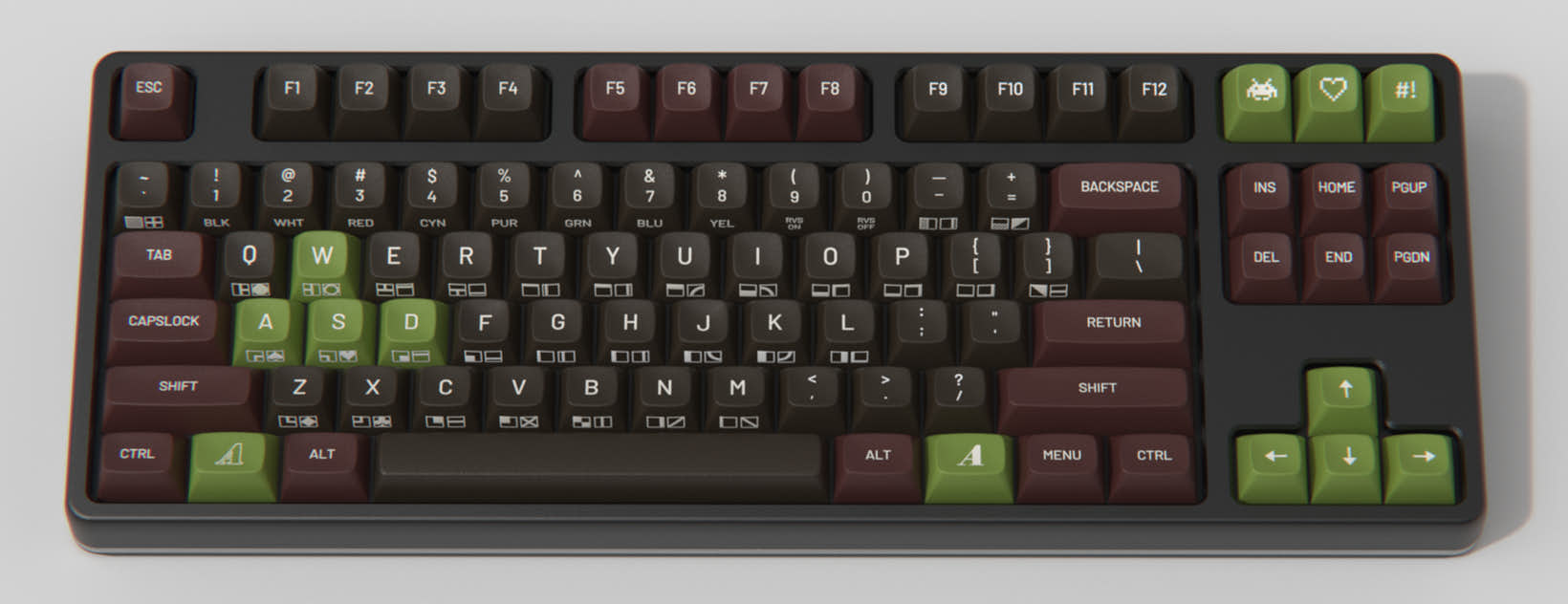
I thought it was time to ramble on about Unicode and UTF-8 a bit, inspired by the need to convert old Amiga text files that have accents in them that won't display properly on my current Macs. Also some food for thought for programmers.
Read the article - posted 2022-01-30
A few months ago, I ordered the Drop + Matt3O MT3 retro keycap set:

These keycaps have the cool/retro "PETSCII" characters printed on the front. But how do you actually type those PETSCII characters?
Read the article - posted 2022-03-23
I thought it might be interesting to talk a bit about how my PETSCII typer web tool came together.
It all started with the Drop + Matt3O MT3 retro keycap set. I ordered this set because I like the old style key shape that's replicated here. And then as a bonus you get the PETSCII characters we know and love from the Commodore 8 bit computers printed on the front of the keycaps.
Not sure how I ended up there, but I found the Style64 C64 TrueType fonts, which replicate Commodore's take on the ASCII character set, usually referred to as PETSCII because the Commodore PET computer from 1977 introduced it.
So now I can have PETSCII graphical characters on my keyboard and PETSCII on my screen. The one missing thing: pressing a key and having the PETSCII character on that key show up on the screen. That's what the PETSCII typer does.
Read the article - posted 2022-03-26
On his Youtube channel, Matt Heffernan has a series of 8-bit Battle Royale videos to see which 8-bit computer is fastest. For this, he uses a simple program to calculate the world's lowest resolution mandelbrot set. Still, the Commodore 64 and ZX Spectrum take minutes to do this in BASIC. It's much faster in assembly.
Watching the videos, I started wondering how 16 or 32 bit computers like the Amiga would perform. Or even the C64 with a C version of the same program. So I made a C version.
Read the article - posted 2022-03-29
Back in the early 1980s, kids such as myself had their first computing experiences with 8-bit home computers such as the ZX Spectrum and the Commodore 64. And the only way, or in Europe in those days, the only affordable way to load games and save/load your own programs was from cassette tape. And boy was that slow.
If we suddenly had a perfectly-reliable cassette tape, how fast could we possibly load data from it? This is a question I started pondering a while ago. To answer it, I had to do look into how data is stored on tape and how exactly we load it. Along the way, we'll find several limits and assumptions we have to work around on our quest for the fastest-possible loading.Read the article - posted 2022-04-03
Although there were definitely other CPUs in use in the 1980s, the vast majority of microcomputers people had at home or at the office used either a MOS 6502 or one of its variants, a Zilog Z80, an early member of the Intel 8086 family, or a Motorola 68000. Let's have a look at those four CPUs.
Read the article - posted 2022-04-19
Last year I got a new webcam, which led me to ask myself what color temperature setting for my Hue lightbulbs would work best with that camera. (Turns out: 4000K.)
But: how do you set your Hue lights to a certain color temperature? I didn't find a good solution for that. So I built my own!
Read the article - posted 2022-07-12
When I wrote my first BGP book I painstakingly made the config examples on actual Cisco routers. In my opinion, it's crucial to make sure that configuration examples that go in a book actually work.
So when I started writing my new BGP book, I did the same. But this time, I used open source routing software (FRRouting) running in Docker containers. Basically, those containers are very light-weight virtual machines.
This makes it possible to run a dozen virtual routers that start up and shut down in just a few seconds. So it's very easy to run different examples by starting the required virtual routers with the configuration for that example.
This was super useful when I was writing the book.
So I thought it would also be very useful for people reading the book.
So I'm making the "BGP minilab" with all the config examples from the book available to my readers. Download version 2022-11 of the minilab that goes with the first version of the book here.
You can also run the examples in the minilab if you don't have the book. And you can create your own labs based on these scripts.
The minilab consist of four scripts:
There are Mac/Linux shell script and Windows Powershell versions of each script.
Permalink - posted 2022-11-11